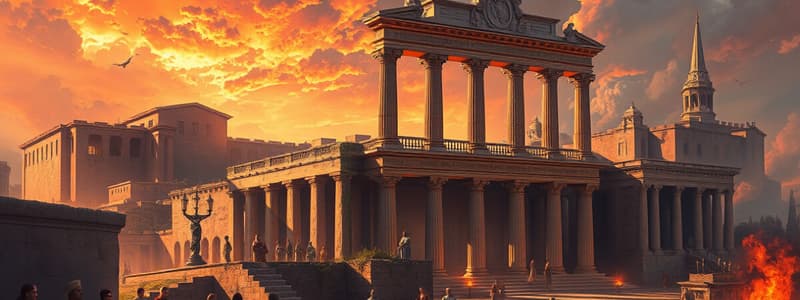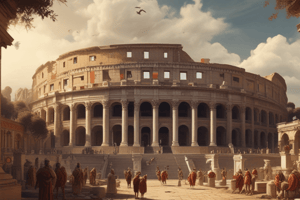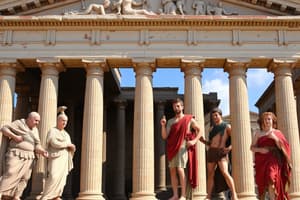Podcast
Questions and Answers
What was a significant feature of the Roman Republic's governance structure?
What was a significant feature of the Roman Republic's governance structure?
- Direct democracy practiced among citizens
- Governed solely by monarchs
- Elected officials including consuls and tribunes (correct)
- Power held exclusively by the Senate
Which major conflict contributed to Rome's dominance in the Mediterranean?
Which major conflict contributed to Rome's dominance in the Mediterranean?
- Punic Wars (correct)
- Gallic Wars
- Social War
- Battle of Actium
What marked the transition from the Republic to the Empire?
What marked the transition from the Republic to the Empire?
- Augustus becoming the first emperor (correct)
- The fall of the eastern provinces
- The adoption of Christianity as the state religion
- The establishment of the Senate as a ruling body
Which architectural innovation did the Romans NOT significantly contribute to?
Which architectural innovation did the Romans NOT significantly contribute to?
Which social class in ancient Rome represented the common people?
Which social class in ancient Rome represented the common people?
What was a major consequence of the fall of the Western Roman Empire in AD 476?
What was a major consequence of the fall of the Western Roman Empire in AD 476?
Which legal document provided an early codification of laws in ancient Rome?
Which legal document provided an early codification of laws in ancient Rome?
Which of the following best describes the primary religion of early Rome?
Which of the following best describes the primary religion of early Rome?
Flashcards
Roman Monarchy
Roman Monarchy
The first form of Roman government, ruled by kings from 753 to 509 BC.
Roman Republic
Roman Republic
The Roman government from 509 to 27 BC; ruled by elected officials and a Senate.
Roman Empire
Roman Empire
The Roman government from 27 BC to 476 AD, ruled by emperors.
Punic Wars
Punic Wars
A series of conflicts between Rome and Carthage (264-146 BC) resulting in Roman dominance.
Signup and view all the flashcards
Twelve Tables
Twelve Tables
A set of Roman laws codified during the Republic, fundamental to Roman law.
Signup and view all the flashcards
Fall of Rome (West)
Fall of Rome (West)
The collapse of the Western Roman Empire in 476 AD due to internal problems and invasions.
Signup and view all the flashcards
Social Structure (Rome)
Social Structure (Rome)
Roman society divided hierarchically into Patricians (elite) and Plebeians (commoners).
Signup and view all the flashcards
Byzantine Empire
Byzantine Empire
The continuation of the Roman Empire in the East after the fall of the West.
Signup and view all the flashcardsStudy Notes
Geography and Origins
- Located in Italy, on the Tiber River.
- Founded in 753 BC, according to legend by Romulus and Remus.
- Developed from a small settlement to a powerful city-state.
Ancient Rome
- Monarchy (753-509 BC): First government led by kings.
- Republic (509-27 BC): Established after the last king was overthrown.
- Senate became a key governing body.
- Expansion through military conquests and alliances.
- Empire (27 BC - AD 476): Initiated by Augustus, the first emperor.
- Extensive territorial expansion across Europe, North Africa, and parts of Asia.
Society and Culture
- Social Structure:
- Patricians (aristocratic families) and Plebeians (common people).
- Slavery was prevalent; slaves were often prisoners of war or debtors.
- Religion:
- Polytheistic beliefs with gods like Jupiter, Mars, and Venus.
- Later, Christianity became prominent, leading to significant changes in the Empire.
- Architecture:
- Innovations like the arch, aqueducts, and the Colosseum.
- Use of concrete revolutionized construction techniques.
Government and Law
- Republic: Governed by elected officials, including consuls and tribunes.
- Legal System: Codification of laws (e.g., Twelve Tables).
- Imperial Rule: Emperors wielded significant power; the Senate's influence diminished over time.
Key Events
- Punic Wars (264-146 BC): Series of conflicts against Carthage; led to Rome's dominance in the Mediterranean.
- Civil Wars: Series of conflicts leading to the end of the Republic, including wars involving Julius Caesar and Pompey.
- Fall of the Western Roman Empire (AD 476): Marked by internal strife, economic troubles, and invasions by barbarian tribes.
Contributions and Legacy
- Law and Governance: Foundations for modern legal systems and governance.
- Language: Latin influenced many modern languages (Romance languages).
- Culture: Contributions in art, literature, and philosophy; authors like Virgil and Cicero.
- Architecture and Engineering: Continued influence on modern architecture and infrastructure.
Decline and Transformation
- Factors leading to decline:
- Economic troubles (inflation, reliance on slave labor).
- Military issues (barbarian invasions, internal corruption).
- Administrative challenges (overextension of the empire).
- Byzantine Empire: Eastern portion of the Roman Empire survived for another thousand years after the fall of the West.
Geography and Origins
- Italy’s capital city, located along the Tiber River.
- Legendary founding date: 753 BC by mythological twins Romulus and Remus.
- Transitioned from a small settlement to a formidable city-state.
Ancient Rome
- Monarchy (753-509 BC): Initially governed by a series of kings.
- Republic (509-27 BC): Established after the last king was ousted; characterized by a Senate as a central governing body.
- Empire (27 BC - AD 476): Marked the reign of Augustus, the first emperor, leading to vast territorial expansion.
Society and Culture
- Social Structure: Divided into Patricians (nobility) and Plebeians (common folk); slavery was widespread, with many slaves coming from war or debt.
- Religion: Originally polytheistic, worshipping deities like Jupiter, Mars, and Venus; the rise of Christianity led to transformative cultural shifts.
- Architecture: Innovations included the arch and aqueducts; construction techniques improved significantly with the use of concrete.
Government and Law
- Republic: Operated through elected officials, such as consuls and tribunes, who represented the populace.
- Legal System: Established codified laws like the Twelve Tables, which laid the groundwork for Roman law.
- Imperial Rule: As emperors gained power, the Senate's authority waned over time.
Key Events
- Punic Wars (264-146 BC): Series of military confrontations with Carthage, resulting in Rome's supremacy in the Mediterranean.
- Civil Wars: Conflicts including notable figures like Julius Caesar and Pompey that contributed to the decline of the Republic.
- Fall of the Western Roman Empire (AD 476): Resulted from a combination of internal conflicts, economic issues, and barbarian invasions.
Contributions and Legacy
- Law and Governance: Established foundational elements that influence modern legal systems.
- Language: Latin's impact on the Romance languages highlights its linguistic legacy.
- Culture: Contributions in literature and philosophy; prominent figures included Virgil and Cicero.
- Architecture and Engineering: Roman innovations continue to shape modern architectural and infrastructural practices.
Decline and Transformation
- Factors contributing to decline included economic instability, military challenges from external threats, and administrative overextension.
- The Byzantine Empire: Survived as the eastern portion of the Roman Empire for approximately a millennium after the fall of the western segment.
Studying That Suits You
Use AI to generate personalized quizzes and flashcards to suit your learning preferences.





